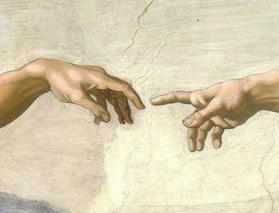In his contribution to Signifying Identities, Fredrik Barth suggests that our notion of political, economic and social boundaries is an extension of the feeling that a tool extends the body:
When you hold a knife or a spoon in your hand and use it as an implement, the experienced limit of your body is no longer the skin of your hand, but the cutting edge of your knife or the cup of your spoon. Likewise, when we learn to use skis or a bicycle, they become extensions of ourselves. Have you not perhaps had that odd shadow of a feeling, as you park your bike, of leaving behind a part of yourself? Take this one step further: when you extend that merging of self and object through time, and make it endure, you create the relationship of possession: of individual property. But to be able to appropriate land to yourself as property, you need to separate a piece of it, detach it as a physical object and thus as an object that you can appropriate and claim as against the world. It is this that requires boundaries: by imposing the conceptual construct of a boundary line around the land you disengage it from its surroundings, and can appropriate it to yourself. (22)
This notion is then projected into more abstracted boundaries and bounded “spaces”: “This elementary figure of a farmer and his family, on the land they possess, bounded and separated from adjoining territories, can readily be projected as a figure of homeland-and-country, with national boundaries demarcating it, and defining the European concept of nation. Metaphorically, we then can project its image to other, non-territorial groups as having ‘social’ boundaries” (23).
Barth emphasizes that this is a Western phenomenon, and argues that in other circumstances “boundary” is much more evident, direct, empirical. In a nomadic society, “The camp community as a group becomes a directly experienced unit, shifting between its two modalities: as a migrating caravan and as a cluster of pitched tents. Physically it is manifest and distinct: not as something contained within an imagined circle drawn on the ground around the group, but directly manifest as against an ever-changing background of new places, no sedentary spectators left behind with every move. . . . Thereby the group itself becomes its own symbol and template, not through the metaphor of a territorial boundary” (23).
Other groups, however, do not seem to be constituted by boundaries at all. Barth describes the Baktaman by their absences: “the absence of co-residence as a feature of family and household, for husband and wife and adolescents always resided separately. The absence of household commonality: joint producers would receive shares of cooked food from one hearth but carry it away with them and consume it, or exchange it, in same-status gatherings, except in the case of mothers and small children. The absence of truly exclusive private property rights” (24).
Barth concludes that it’s “misleading to import the particular cluster of images and assumptions that we associate with a concept of boundaries to describe the outcomes of group and identity formation among Baktaman, if no such boundary imagery has been involved in the processes that generate these groups and identities” (25).














